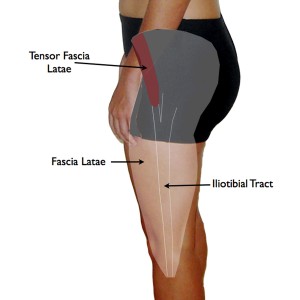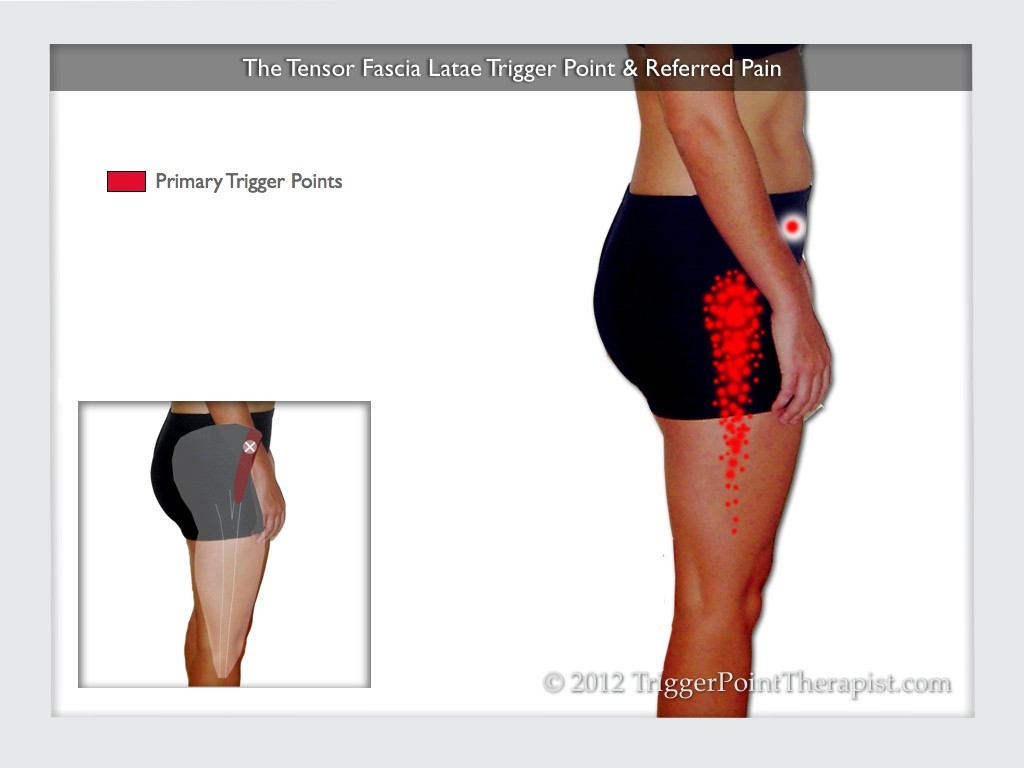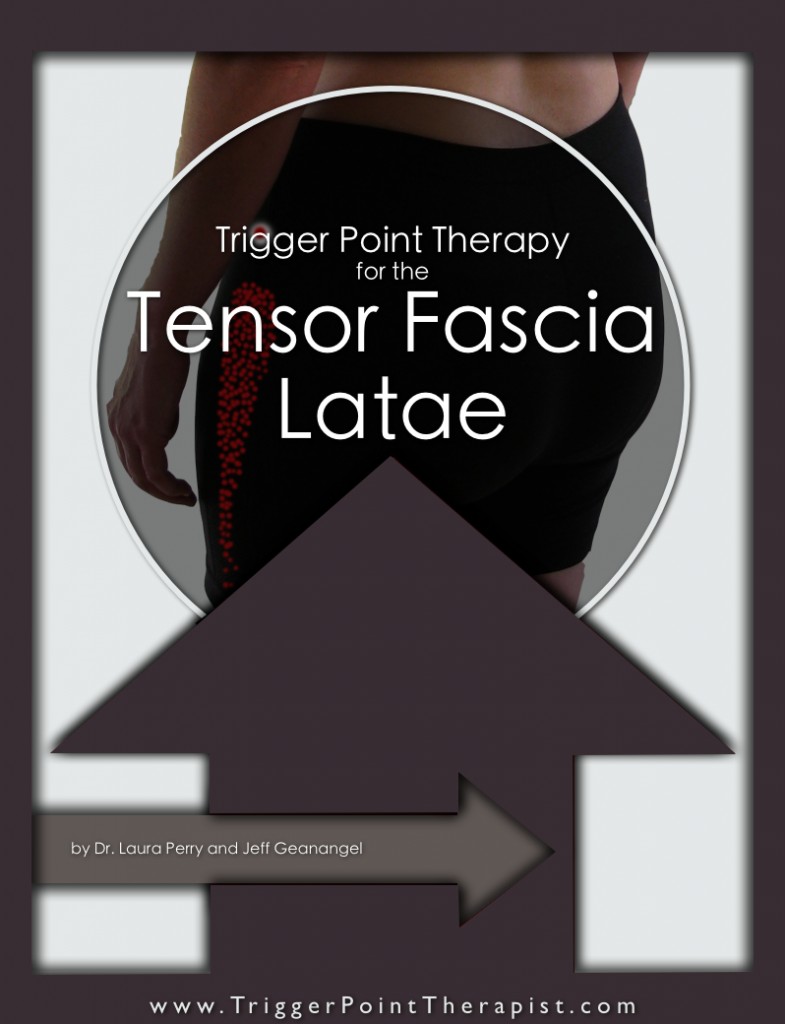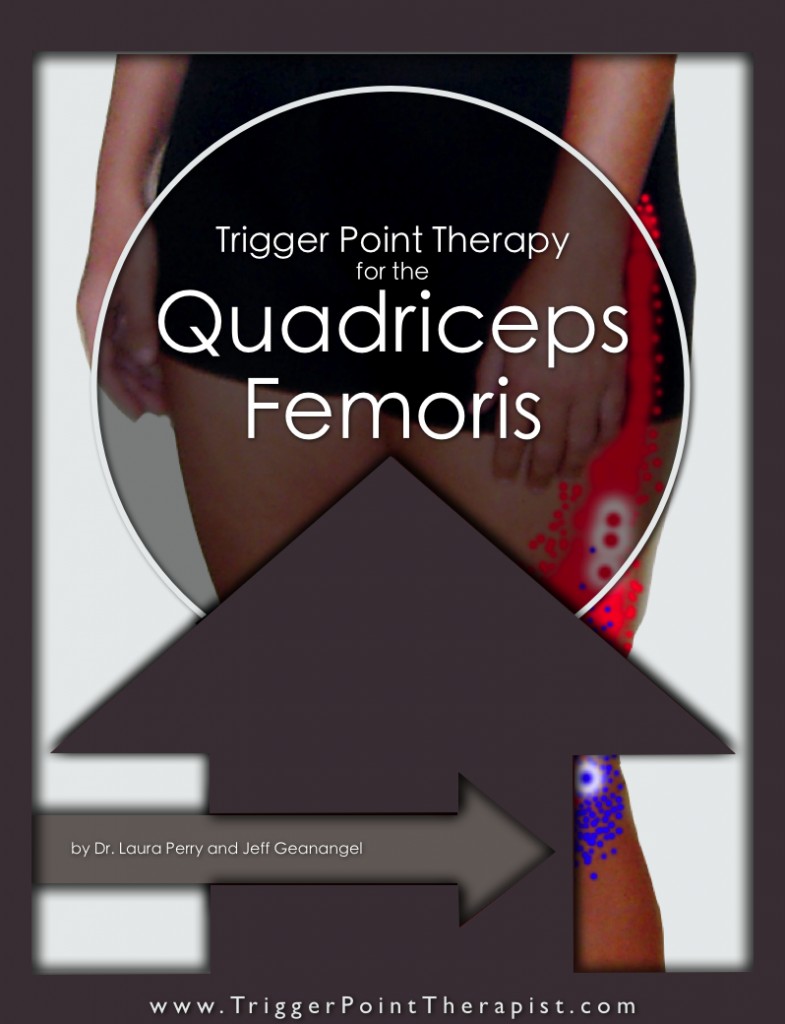The Tensor Fascia Latae ( also spelled Tensor Fasciae Latae or Tensor Fascia Lata, but commonly referred to as the TFL ) is a small muscle that lies just in front of the hip joint. It has a very long tendon, called the iliotibial tract or IT Band, that travels all the way down the outside of the thigh to attach just under the knee joint.
The trigger point in this muscle refers pain deep into the hip joint and down the outside of the thigh. An active or latent TFL trigger point can also produce excessive tension in the muscle and iliotibial tract that contributes to a condition known as IT Band Syndrome. It should be noted that a portion of the gluteus maximus muscle fibers also attach to the IT Band and may also be involved with his condition.
Despite its well publicized role in IT Band Syndrome, the TFL trigger point is my “go-to” trigger point in most cases of hip pain and hip joint dysfunction. In acute cases of hip pain it may be the only trigger point involved. But the majority of hip pain cases that I see in my practice are chronic conditions with trigger points in four to five muscle groups playing a role in them.
The Tensor Fascia Lata Muscle
Location: This relatively small muscle is found on the side of the pelvis and runs downward in front of the hip joint to blend with the iliotibial tract just below the hip joint.
Function: This muscle functions primarily to control movement of the leg during the stance phase of walking. It also works to keep the pelvis level when the opposite leg is raised off the ground during walking (assisting the gluteus medius and gluteus minimus muscles). It may also help to stabilize the knee joint during weight bearing activity.
Muscle Structure: The upper attachment of the TFL originates along the outer aspect of the Iliac Crest (of the pelvis) and Anterior Superior Iliac Spine (A.S.I.S). The muscle has two functionally distinct sections, the anterior and posterior fibers. The anterior fibers become tendinous as they run down the outside of the thigh and attach to the connective tissue encapsulating the knee joint. The posterior fibers join the iliotibial tract (a central thickening of the large fascial sheath covering the outside thigh) and attach to the lateral tubercle of the tibia leg bone.
Muscle Actions: The TFL assists with abduction, medial rotation, and flexion of the thigh at the hip. Additionally, the anterior fibers assist with flexion of the lower leg at the knee, while the posterior fibers provide stability to the knee joint during movements such as walking and running.
Biomechanical Considerations: The TFL is primarily overloaded during jumping, running, and climbing activities, though specialized activities such as kicking in martial arts or kickboxing can easily push this muscle beyond it’s conditioned capacity.
Synergistic Muscle Groups: The following muscle groups share common biomechanical functionality with the TFL and may become overloaded if it is unable to perform its workload due to trigger point activity or injury:
- The TFL assists the rectus femoris, iliopsoas, and anterior fibers of both the gluteus medius and gluteus minimus muscles in producing flexion of the thigh at the hip joint.
- During abduction of the thigh at the hip, the TFL is assisted by the gluteus medius and gluteus minimus.
Antagonistic Muscle Groups: The following muscles oppose the movements produced by the TFL and may develop trigger point activity in response to neurological distortions.
- The gluteus maximus and hamstring muscles oppose the hip flexion produced by the TFL.
- The adductor magnus (and other hip adductors) muscle opposes the TFL’s role in hip abduction.
The Tensor Fascia Lata Trigger Point
As shown in the diagram below, only one trigger point is found in the TFL and it is located in the upper region of the muscle just below where it attaches to the A.S.I.S.
Tensor Fascia Lata Pain
As shown above, the referred pain pattern associated with this trigger point covers the entire hip joint and extends down the outside aspect of the thigh, sometimes nearly to the knee joint. Tenderness to touch may also be prominent in the hip joint and down the thigh as well.
Tensor Fascia Lata Trigger Point Symptoms & Findings
Clients with an active TFL trigger point will present with any or all of the following symptoms or clinical findings:
- Pain and/or soreness in the hip joint (greater trochanter) and down the outside thigh during movement of the hip.
- Pain prevents them from walking quickly.
- Unable to sit in a deep (or low) chair or flex their hip more than 90°.
- Unable to lie on the affected hip during sleep and unable to lie on the unaffected side during sleep without a pillow between their knees.
- Patient will tend to keep the affected hip slightly flexed when standing or walking, and will avoid leaning backwards and/or extending the hip.
- Using crutches to walk typically eliminates the pain.
- Adduction of the thigh at the hip is limited to 15° or less.
- Swinging the leg on the affected side up and to the side (hip abduction) may be painful.
- Ober Sign: When lying on the unaffected side, the patients upper knee (on the affected side) will not be able to rest on the table. This limited range of motion is due to tightness in the iliotibial tract from TFL trigger point activity (and possibly gluteus maximus trigger point activity too).
What Causes the TFL Trigger Point?
The following events or activities may activate or reactivate the TFL trigger point:
- Landing on the feet from a high jump can acutely overload the TFL.
- Jogging or running uphill or downhill.
- Any activity or posture that causes the foot to pronate in compensation, such as running or walking on uneven surfaces or being bowlegged. Look for greater wear on the outside edge of the shoe sole.
- Sitting for prolonged periods, such as when driving long distances.
- Sleeping in the fetal position.
- A standing posture with a forward-tilting pelvis and exaggerated lumbar lordosis.
Differential Diagnosis
The following disorders may share similar symptoms with that produced by the TFL trigger point and may be confused with its activity:
- Trochanteric Bursitis: Inflammation of the hip bursa produces pain and tenderness in the hip joint region that is very similar to the TFL trigger point. Patients are often misdiagnosed as having Trochanteric Bursitis when they actually just have an active TFL trigger point.
- Sacroiliac Joint Arthritis (Sacroilitis): Pain from S.I. joint arthritis may extend to the lateral thigh region, but unlike TFL referred pain it will often extend beyond the knee and also into the low back and buttock regions.
- L4 Neuropathy: Compression of the L4 spinal nerve by a bulging disc can have similar symptoms to a TFL trigger point.
- I.T. Band Syndrome: This condition is typically seen in runners and produces pain and tenderness around the outside of the knee and lower thigh. It may be caused by trigger point activity in the TFL and/or gluteus maximus muscles that produces excessive tension in the iliotobial tract, causing it to rub back and forth. It is typically seen in bowlegged runners or runners that have excessive wear on the lateral sole of their running shoes.
- Meralgia Parasthetica: This pain syndrome is caused by the entrapment of the lateral femoral cutaneous nerve as it exits the pelvis. It’s symptoms include burning pain and numbness/tingling sensations along the outside and front of the thigh. The pain is worsened by hip extension and is relieved by sitting down or flexing the leg at the hip. This condition shares many symptoms with TFL trigger point activity.
Treatment of the Tensor Fascia Lata Trigger Point
I designed and use a simple release technique for the TFL trigger point that combines a pressure-release of the trigger point with passive stretching of the muscle. If you make sure that the client’s body is positioned correctly during the release, it is very effective at eliminating the referred pain and tenderness produced by this trigger point.
In hip pain cases, you are probably also going to need to address the trigger points in the gluteus minimus and quadratus lumborum muscles to achieve long lasting results. In fact, with chronic cases of hip pain you are going to need to use the Trigger Point Therapy for Hip Pain Protocol to have a reasonable chance at helping these people.
With clients presenting with IT Band Syndrome, be sure to also include the vastus lateralis trigger points in your treatment plan.
The Tensor Fascia Lata Trigger Points Video
You can view a sample from the TFL Trigger Point video on YouTube by clicking on the image below:
Related Articles:
- The Quadratus Lumborum Trigger Points: Masters of Low Back Pain
- Gluteus Minimus Trigger Points: A Small Muscle With A Big Mouth
- Vastus Lateralis Trigger Points: The Knee Pain Trigger Points – Part 1
Related Instructional Videos:





